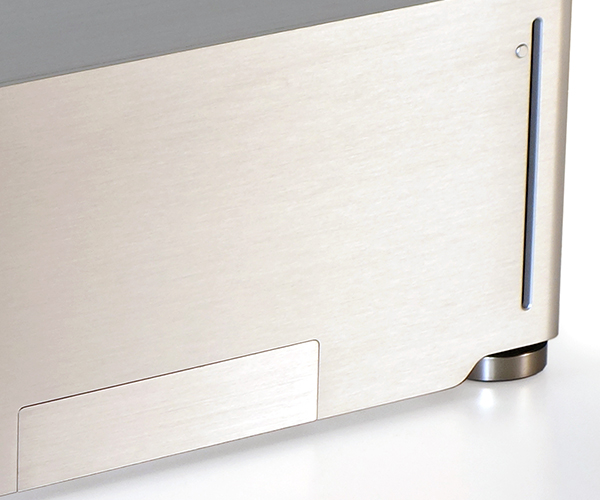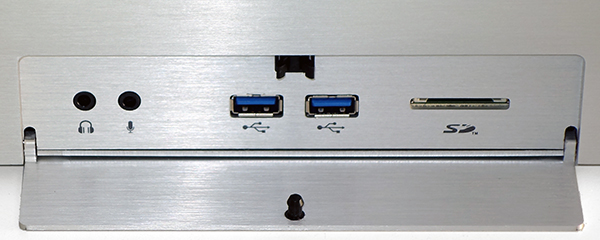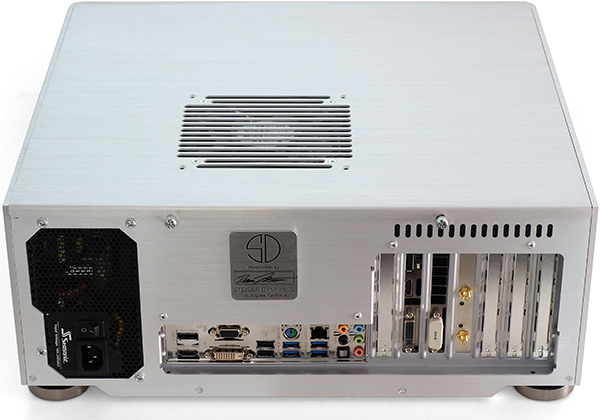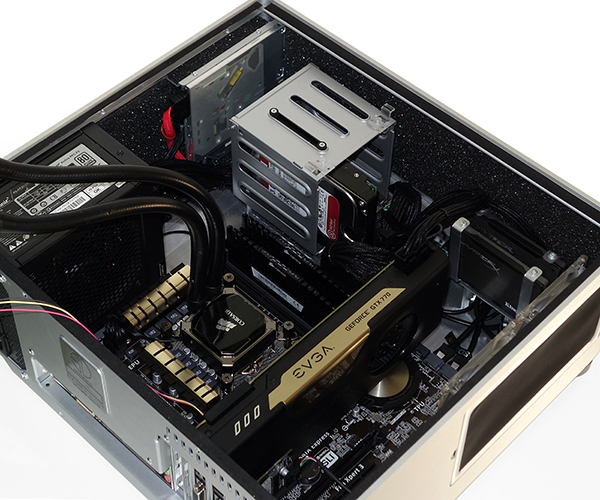Steiger Dynamics Maven Pure Custom PC Review: Game In Silence
Getting To Know The Maven Pure
With a thick face panel that wraps around the sides, Steiger Dynamics’ Maven chassis resembles the super-expensive S15V from OrigenAE, but with a smaller access panel and no digital display. Rather than hide the Blu-ray burner behind a door, Steiger Dynamics uses a slot-loading version.
The smaller panel hides a simplified connector set, with two USB 3.0 ports, headphone and microphone jacks, and an SD flash media interface.
The Maven chassis doesn’t have any rear-panel fan mounts, and instead has a 140/120 mm mount on its lid. This gives Steiger Dynamics more room for the super-quiet, closed-loop liquid cooler in our test configuration.
Note that the I/O panel port section represents Asus’ Z97-A. A recent switch to the similar Z97-AR helped Steiger Dynamics ditch the integrated VGA and DVI-D ports, while retaining the DisplayPort and HDMI outputs. The removed connectors are even less important to anyone who orders their system with a discrete graphics card, as shown.
Corsair’s H60 quietly cools Intel’s Core i5-4690K, EVGA’s GeForce GTX 770 pushes pixels quickly without much acoustic output, Seasonic’s Platinum Power SS-660XP2 feeds those devices at nary a whisper, and the entire assembly relies on high-efficiency components and reduced thermal output to retain low fan speeds.
Two Kingston HyperX 120 GB SSDs in RAID 0 offer exceptional performance noiselessly, while a 3 TB Western Digital Red drive provides NAS-oriented mechanical storage for user data. Super-thick panels keep most of the hard drive’s noise from being transferred out of the case, and foam padding on all large surfaces helps prevent it from being reflected out of the Maven’s vents.
Get Tom's Hardware's best news and in-depth reviews, straight to your inbox.
Current page: Getting To Know The Maven Pure
Prev Page A Spark Of Brilliance Next Page Maven Pure Customizations-
lunyone Did I miss the price on this?Reply
"The price for this machine is only $330 over the self-built option, with us using the closest-matching $400 OrigenAE case. If you subtract the $49 overclock fee and $99 cable service, Steiger only has about $189 in mark-up." -
ta152h This seems like a solution looking for a problem.Reply
Quiet PCs are great, and most of the early ones were completely quiet. But, for gaming? It's not as clear. For the same performance I can save a load of money, or get much better performance for the price.
For listening to Mozart's g minor string quintette? Great. For blowing up bridge or shooting aliens with a machine gun? I'm just not sure sound matters as much. For a living room box that does most things fine, and is quiet, I'll take a 35 watt Kaveri, and still have enough money left over to make a more powerful machine than this $2600 monster.
I also don't understand the relatively cheap processor. For $2600 (which is what the ad says, but the author never seemed to mention, so it's hard to be sure), the processor should be the i7-4970K. Haswell-E might work too, but probably the 4970K would be best.
Someone is going to want this, but I think it's very limited in scope. Silence, or near silence, is great for computers, but for different segments. Most gamers want performance for their dollar, and this falls short.
-
Crashman Reply
$2578 like the link above it shows, for this exact configuration. The base price for this system is $999, so you can see it has a lot of upgrades.14277126 said:Did I miss the price on this?
"The price for this machine is only $330 over the self-built option, with us using the closest-matching $400 OrigenAE case. If you subtract the $49 overclock fee and $99 cable service, Steiger only has about $189 in mark-up."
The next guy after you suggested using cheaper parts. We have the SBM for that.
-
lunyone Reply$2578 like the link above it shows, for this exact configuration. The base price for this system is $999, so you can see it has a lot of upgrades.
I thought is was an ad price listed like the ads listed on other pages, so I guess I just assumed that was an ad price :)
The next guy after you suggested using cheaper parts. We have the SBM for that.
For a gaming/htpc I think this is just too much $. I would have went with something below $6-800, but that is just me. -
photonboy In what universe is this a good value?Reply
You can build a quieter computer with a better video card (GTX970) for about HALF THE PRICE. I built a system and here are the only noise elements:
1) Noctua cooler (runs at 300RPM in idle)
2) BeQuiet PSU (inaudible)
3) Asus Strix GTX970 (has 0dB mode)
I don't have the card yet but it would be completely silent unless doing heavy gaming. My system can't be heard from one foot away in a silent room.
Other:
- 2xRAID0 for SSD is pointless in the real-world.
- not sure where that "16dB" number came from considering the PC has a pump, a radiator fan, and a GTX770. That's pretty much impossible. -
Crashman Reply
I don't think you understand. It's the build cost that's a good value. You can pick your own parts. Well, except for the case.14277529 said:In what universe is this a good value?
You can build a quieter computer with a better video card (GTX970) for about HALF THE PRICE. I built a system and here are the only noise elements:
1) Noctua cooler (runs at 300RPM in idle)
2) BeQuiet PSU (inaudible)
3) Asus Strix GTX970 (has 0dB mode)
I don't have the card yet but it would be completely silent unless doing heavy gaming. My system can't be heard from one foot away in a silent room.
Your response is like someone saying "How can you call $8 for two 8 oz Fillet Mignons a good deal? I just paid $4 for a pound of hamburger!"
I see you didn't read the article. There's a page called "Power, Heat, and Noise". If you choose to scroll to the bottom of that page, you'll see something that's impossible. And then maybe you'll understand why the company used all these overpriced parts.14277529 said:Other:
- 2xRAID0 for SSD is pointless in the real-world.
- not sure where that "16dB" number came from considering the PC has a pump, a radiator fan, and a GTX770. That's pretty much impossible.
What you won't be able to explain is how they're "overcharging" for this exact configuration. Which means, as a builder, they're offering you a good rate. Aka, a fair deal.
-
Crashman ReplyIn what universe is this a good value?
In what universe is it a good idea to repeat the question seven minutes after I answered it?
...
- not sure where that "16dB" number came from considering the PC has a pump, a radiator fan, and a GTX770. That's pretty much impossible.
-
Pikime the problem with having a high performance machine in the lounge room like this is it would be more effective (granted maybe not more simple) to have your existing desktop rig (as i presume most people interested in tv gaming on a pc) to stream to a tiny actually silent box. for the media stuff you can even get a raspberry pi to run xbmc and stick it behind you tv and stream from a NAS or other big computer, for the gaming you could get something more powerful like a NUC and steam stream or limelight or similar in home streaming which is starting to take off nowReply -
photonboy Crashman,Reply
If you read the conclusion he says the cost is only a couple hundred dollars more than building your own which I disagree with so I think it's fair to comment on his "value" comment.
*I just added up the cost of all the parts, and NOT COUNTING THE CASE but including the software the total comes to $1500 USD.
The cost to buy this machine with these specs was almost $2600. Now if we use $300 for a similar case since I don't think you can buy the case on its own the price difference comes to about $800USD.
*So you can build the same EXACT setup with a difference case and save $800USD by doing it yourself. That is hardly "a couple hundred dollars" difference as stated in the article. -
Crashman Reply
I added up the cost of all the parts when I wrote the article:14277718 said:Crashman,
If you read the conclusion he says the cost is only a couple hundred dollars more than building your own which I disagree with so I think it's fair to comment on his "value" comment.
*I just added up the cost of all the parts, and NOT COUNTING THE CASE but including the software the total comes to $1500 USD.
The cost to buy this machine with these specs was almost $2600. Now if we use $300 for a similar case since I don't think you can buy the case on its own the price difference comes to about $800USD.
*So you can build the same EXACT setup with a difference case and save $800USD by doing it yourself. That is hardly "a couple hundred dollars" difference as stated in the article.
Processor 235
Graphics 350
Motherboard 150
Memory 180
System Drive 150
Power 145
Wi-Fi 33
System Drive 125
CPU Cooler 65
Storage Drive 125
Optical 90
case 400
OS 100
Playback SW 100
Overclock 0
Cable Sleeving 0
2248
Prices might have changed a little since I wrote the article, but I bet you'd find any large changes in a component price are eventually picked up by this builder. Moreover, I priced the parts using Google product search and top venders (Newegg, Tigerdirect, Directron, etc) wherever applicable (case and ODD were only available from small venders) on the SAME DAY that I priced the finished system at Steiger Dynamics.
Look, nobody likes to admit they're wrong, that's why I kept a record of all the part prices when I made those calculations. I wanted to be sure that when someone came in here to question my analysis, I'd have the data to prove its validity.





